Pilot Pentland Firth and Orkney Waters Marine Spatial Plan - Sustainability Appraisal
This report summarises the findings of the Sustainability Appraisal undertaken on the draft pilot Pentland Firth and Orkney Waters Marine Spatial Plan incorporating a Strategic Environmental Assessment (SEA) required under Directive 2001/42/EC and the Env
7 Baseline Information
7.1 Introduction
7.1.1 A key component of the SEA and Socio-economic Assessment processes is the collation of relevant baseline information, and the use of this information in informing the development of the PPS upon which the assessments are being conducted. As the draft Pilot Plan was developed, the relevant information for environmental, social and economic aspects was compiled. This information was collated into the Baseline Information presented in the following sections of this Report, and in the accompanying Socio-economic Baseline Report.
7.2 Scoping of topics for inclusion in the assessment
7.2.1 In order to establish the environmental, social and economic effects of the draft Pilot Plan, it is necessary to understand the features that are likely to be affected. The SEA Screening and Scoping Report identified a range of data sources that provided a baseline for the SA, and the Initial Environmental Report built upon this to present an initial baseline commentary. This data, in addition to sources suggested by the Consultation Authorities in their responses on the initial Environmental Report, and with the consideration of social and economic factors via the Socio-Economic Assessment process, has been used to develop the baseline information presented in this Report.
7.2.2 The scope of environmental and socio-economic issues considered to be likely to be affected by the draft Pilot Plan and included in this SA is set out in Table 7.1. As noted in Section 6.2, the consideration of environmental issues in relation to air was scoped out of the SEA as it was considered that there would not be significant effects on this from the adoption of the Plan. Whilst the consideration of GHG emissions has been noted, this is discussed within the Climate Change topic area in the assessment. The development of the Material Assets and Communities, Population and Human Health sections in this report have been expanded beyond that typically considered for SEA, to include the consideration of socio-economic effects relating to the draft Pilot Plan.
7.2.3 Sections 7.3 to 7.11 set out the relevant aspects of the environmental baseline and provide an overview of the socio-economic baseline for each of the topic areas detailed above. Specific focus has been given to those characteristics which have the potential to be affected by development in the PFOW area and on taking a proportional approach to the assessment process. The likely evolution of the baseline in the absence of the plan is discussed in Section 7.12. 0.
| SA Topic Areas | Scoped In |
|---|---|
| Biodiversity, Flora and Fauna | ◘ |
| Climatic Factors | ◘ |
| Cultural Heritage | ◘ |
| Landscape and Seascape | ◘ |
| Soil, Marine Geodiversity and Coastal Processes | ◘ |
| Communities, Population and Human Health | ◘ |
| Air | X |
| Water | ◘ |
| Material Assets | ◘ |
7.3 The PFOW and the Pilot Plan Area
7.3.1 The Pentland Firth is a stretch of water that joins the North Atlantic to the North Sea, separating Orkney from the north coast of mainland Scotland. The Pilot Plan Area, referred to in this SA as the PFOW area, consists of many distinct areas, including the Orkney archipelago comprising approximately 70 islands with over 1,200 km of coastline; the varied coastline across the extent of the north Caithness and Sutherland coast from Cape Wrath in the west to Duncansby Head; and islands such as Stroma, Muckle Skerry and Pentland Skerries located within the Pentland Firth itself.
7.3.2 Between them, these areas are known for their great natural beauty; internationally and nationally recognised flora, fauna and habitat features; and valuable natural resources that support and wide range of industries and sectors as well as the many communities that call the area home. The coastal and marine environments have played a major role in shaping life the area, and has made an important contribution to local, regional and national culture and history, in many cases dating back millennia. As such, the area contributes heavily to the dependence of many communities and industries on the wide and varied resources that they contain.
7.3.3 The Pilot Plan Area is presented in Figure 3.2.
Overview
7.4.1 The waters of the Pentland Firth and around Orkney are rich in biodiversity, supporting a wide range of valuable and important habitats and species habitats; many of which are considered rare and/or vulnerable. In addition to forming key elements of the quality of biodiversity in the PFOW and Scotland’s seas, these species and habitats also provide environmental and economic benefits.
Habitats
7.4.2 The value of many marine and coastal habitats such as submerged reefs, maerl beds, sandbanks, salt marshes and dune systems including machair [24] , is demonstrated through their designation at the European (e.g. EC Habitats Directive (92/42/ EEC), Special Areas of Conservation ( SAC)) and national levels (e.g. Sites of Special Scientific Interest ( SSSI)).
7.4.3 There are four SACs in Orkney (Sanday, Loch of Stenness, Stromness Heaths and Coast, and Hoy) and three SACs on the north Caithness and Sutherland coast (Strathy Coast, Invernaver, and Caithness and Sutherland Peatlands), designated for the protection of marine and coastal habitats [25] , with some 29 sites with coastal or marine biodiversity interests on Orkney and along the north Caithness and Sutherland coast receiving protection as SSSI [26] , [27]. A range of important habitats are also recognised due to their importance to priority species in the UK Biodiversity Action Plan ( UKBAP) list [28] , which is implemented at the local level through the development of Local Biodiversity Action Plans for Orkney [29] and the Scottish Highlands [30] .
7.4.4 Scottish Ministers are committed to setting up a national network of ecologically coherent Marine Protected Areas ( MPAs) to protect features of biodiversity and geodiversity conservation importance in both inshore and offshore waters adjacent to Scotland. This is demonstrated by the designation of a suite of 30 nature conservation MPAs by Scottish Ministers in July 2014, comprising 17 areas in Scotland’s territorial waters and a further 13 in offshore waters. Of these, three MPAs were identified in the PFOW with biodiversity interests (e.g. North-west Orkney for sandeel interests; Wyre and Rousay Sounds for kelp and seaweed communities on sublittoral sediment and maerl bed interests; and Papa Westray for black guillemot interests) with a further two MPAs located to the south of the PFOW region near Wick (e.g. Noss Head and East Caithness Cliffs). A further four MPA proposals were also identified in Scottish territorial waters requiring further assessment [31] [32] .
7.4.5 Out with these designations, some 27 seabed habitats are considered to be Priority Marine Features ( PMF), including many considered to be characteristic of Scotland’s marine environment. These features range from kelp beds and flame shell beds in coastal areas to cold-water reefs and offshore deep sea muds in deeper seas, and are considered to be of conservation importance [33] .
Species
7.4.6 The PFOW are internationally renowned for their importance to many species ranging from seabirds and wintering waterfowl to a variety of marine mammals (e.g. cetaceans, seals) and other marine fauna (e.g. fish, elasmobranchs).
7.4.7 Scotland holds internationally important numbers of 24 species of breeding seabirds, and these are often considered to be an important indicator to the state of the marine environment. The Caithness and Orkney coastlines are recognised for their importance in supporting extensive colonies of migratory and breeding seabirds such as Atlantic puffins, Black-legged kittiwakes, Arctic skuas, Arctic terns, Razorbills, Northern fulmars, Common guillemots, Storm petrels, Northern divers, Slavonian grebes and Greater black-backed gulls. The PFOW region also plays an important role for seabirds that breed out with this area, and its coastal and marine waters serve as important feeding grounds. For example, Sule Skerry and Sule Stack located 60 km off the Orkney Mainland support bird colonies of species such as gannets and European shag that feed in the PFOW area. Similarly, there are many sites on the north Caithness and Sutherland coast and further afield that support a wide range of bird species utilising the PFOW for feeding grounds. In addition, many coastal areas contain saltmarsh and wetland areas that also support breeding or overwintering wading birds.
7.4.8 Some marine species, such as many seabirds, are afforded protection under the Wildlife and Countryside Act 1981, whilst other endangered species are classed as European Protected Species ( EPS). Rare and vulnerable birds also receive protection within the European Birds Directive (79/409/ EEC) and are afforded protection at the national level through the designation of Special Protection Areas ( SPAs), and it is not surprising that the importance of this region for many species and populations is further reflected by the designation of 12 SPAs in coastal areas in Orkney and along the north Caithness and Sutherland coast. Several of these have also been designated as Ramsar sites, and additional SPA designations located in inland areas also have coastal interests (e.g. breeding red-throated divers which breed on small lochs but feed at sea).
7.4.9 Amongst these, SPAs have been designated for migratory and breeding seabirds, wading birds and one has been designated as a Ramsar site under the international convention on the protection of wetlands and waterfowl. Seaward extensions have been applied to some SPAs, including several located on the north Caithness and Sutherland coast such as the North Caithness Coast SPA that extends along a large stretch of the northern coastline. This area also contains some five separate SSSIs which are designated for bird species, in addition to the protection of important maritime and coastal habitats [34] .
7.4.10 The UK government has also committed to identifying a network of SPAs in the marine environment, and having them substantially classified, by the end of 2015. At this stage, a suite of 14 draft SPAs ( dSPAs) have been identified by the Joint Nature Conservation Council ( JNCC) and SNH in Scotland’s marine environment. These sites have been identified to alert stakeholders to additional marine sites that are likely to be considered by the Scottish Government for designation, including two sites within the PFOW (North Orkney dSPA and Pentland Firth and Scapa Flow, Orkney dSPA) identified for species listed under Annex 1 of the Birds Directive and for regularly occurring migratory bird species [35] .
7.4.11 Some 11 Royal Society for the Protection of Birds ( RSPB) Reserves have been created in Orkney, from Hoy in the south to North Hill in the north and Copinsay in the east. Whilst not formal designations, several Important Bird Areas ( IBA) have also been identified by Birdlife International in the region. The largest two areas are located at Hoy [36] , based upon its importance for breeding seabirds, waders and raptors, and at Scapa Flow, considered to be important for wintering waterbirds [37] . The locations of these areas are presented in the RLG.
7.4.12 In addition to birdlife, the waters of the Pentland Firth and Orkney region also support a wide range of fish species and marine mammals, as do those along the north Caithness and Sutherland coast. The PFOW are internationally recognised for their importance for seal populations in particular [38] , demonstrated by the designation of a harbour seal conservation area surrounding the Orkney Isles, the presence of two SACs within Orkney waters for breeding seal colonies (i.e. Faray and Holm of Faray for grey seals, and Sanday for harbour seals) [39] , and in studies such as seal density mapping undertaken by the Sea Mammal Research Unit ( SMRU) [40] . As shown in Figure 7.3, designated seal haul out sites are located throughout the Orkney Isles, within the Pentland Firth (i.e. near Stroma, Muckle Skerry and the Pentland Skerries), and on the north Caithness and Sutherland coast (i.e. near Gills Bay, Duncansby Head, Whiten Head, Eilean Hoan and Kyle of Tongue) [41] .
7.4.13 The harbour seal population over much of Scotland’s east coast and Northern Isles has shown a marked decline in recent years. In 2013, just 1,865 harbour seals were counted, equating to a decline of around 30% over the last three years alone; a rate of decline in line with the annual rate observed since 2006 [42] . A 2014 report produced by the Natural Environment Research Council ( NERC) Special Committee on Seals ( SCOS) noted a decline of 76% since 2001 in of seals in Orkney [43] . A 2013 report showed regional differences in the severity of the decline in harbour seal numbers in Orkney. The outer islands in the northeast had the highest counts of harbour seals, peaking in 1997, and this region has showed the greatest decline. The north and east mainland and adjacent islands (comprising Rousay, Shapinsay and Deerness, amongst others) has showed a slow and more gradual decline since the late 1980s. In the third region comprising Scapa Flow, south and west mainland and the southern islands (including Hoy, South Ronaldsay and Flotta, amongst others) harbour seal counts peaked in 1997 and have since declined. On the north coast of the Scottish mainland, some 73 harbour seals were counted in 2013, equating to a similar rate of decline since the previous survey in 2008 [44] . This count was the lowest recorded to date.
7.4.14 Approximately 38% of the world’s grey seals breed in the UK, of which some 88% of these breed at colonies in Scotland, and the main concentrations are in the Outer Hebrides and Orkney [45] . While grey seal numbers have increased in Orkney over a long period of time to the late 1990s, there has been a significant decrease in the rate of pup production [46] and population growth appears to be levelling off [47] . A 2013 survey noted that “the numbers of grey seals in Orkney in August has remained remarkably constant”. However, the surveys also indicated that the counts of both grey and harbour seals in the Sanday SAC has declined since 1997 [48] , [49].
7.4.15 Many other species have been sighted within the Pentland Firth and around Orkney, and many of these, such as whales, dolphins and porpoises, are identified as species of European Community interest and afforded protection under Annex IV of the Habitats Directive. Some nineteen cetacean species have been recorded in the PFOW since 1980, and of these, six species occur regularly (i.e. harbour porpoise, minke whale, white-beaked dolphin, Risso’s dolphin, killer whale and bottlenose dolphin). Several, such as Bottlenose dolphins and Harbour seals, are also listed under Annex II of the Habitats Directive. Others cetaceans such as short-beaked common dolphin, atlantic white-sided dolphin, long-finned pilot whale and sperm whale have also been sighted and are casual visitors to the area. Others, such as common skate and basking sharks have also been sighted within the PFOW region [50] . Both species are listed as UKBAP species [51] and/or identified on the International Union for the Conservation of Nature ( IUCN) Red List of Threatened Species [52] .
7.4.16 Scotland’s waters support a rich variety of fish species, including several species that are known to migrate through the PFOW. The waters around Orkney in particular host valuable spawning grounds for many fish species, including commercial species such as herring and whiting. Nursery grounds for species such as sandeels and nephrops are also located in or near to the region; the importance of sandeel habitats in particular is reflected in the MPA located to the north-west of Orkney. However, there remains a high degree of uncertainty and data gaps, particularly relating to spawning activities [53] . In addition to being important commercial assets for the fishing sector, species such as cod, haddock and whiting are also important food sources for seabirds and marine mammals, and as such, impacts to these species can have secondary effects on predator species. As one such example, it is thought that declines in sandeel populations have contributed to fluctuations in puffin numbers [54] .
7.4.17 Some 55 species identified in Scotland’s seas have been identified as PMFs. While not formal designations, these species have been identified by SNH and JNCC as being of conservation importance, and the development of the PMF has been developed to help focus future conservation action, research, education and to promote a consistent approach to marine nature conservation advice. These features range from species with low or limited mobility such as fan mussels to mobile species such as basking sharks and seals, amongst many others [55] .
7.4.18 The importance of both Atlantic salmon and sea trout in Scottish waters is demonstrated by the inclusion of the marine life stages of both species as PMFs. Salmon rivers and sea trout spawning burns have been identified within the PFOW, and a number of significant salmon rivers are located within Caithness, along the north Sutherland coast and on the eastern coastlines of Scotland. Many sites, such as the Rivers Borgie, Naver, Thurso, and Berriedale and Langwell Waters located on the north Caithness and Sutherland coast, have been designated as SACs due to salmon interests, amongst other features (see Figure 7.4). The Pentland Firth is believed to be an important migration route for Atlantic salmon, particularly for those from salmon rivers located on Scotland’s east coast. However, there is some uncertainty surrounding the migratory patterns of adult or post-smolt Atlantic salmon through and out with Scottish waters, particularly over whether migration occurs through or around Orkney, and over whether the Pentland Firth is the preferred or only route used [56] .
Key pressures for biodiversity:
- Potential for adverse effects on marine and coastal habitats and species from increased development in marine and/or coastal areas (e.g. disturbance, barrier effects, damage to or loss of habitats, pollution).
- Potential for adverse effects on marine and coastal habitats and species from the effects of climate change (e.g. acidification, displacement by invasive nonnative species, coastal erosion).
- Potential for cumulative or in-combination effects on biodiversity interests from increased use of coastal and marine environments (e.g. disturbance, barrier effects, damage to or loss of habitats).
Figure 7.1 International Nature Conservation Areas in the PFOW Area [57]
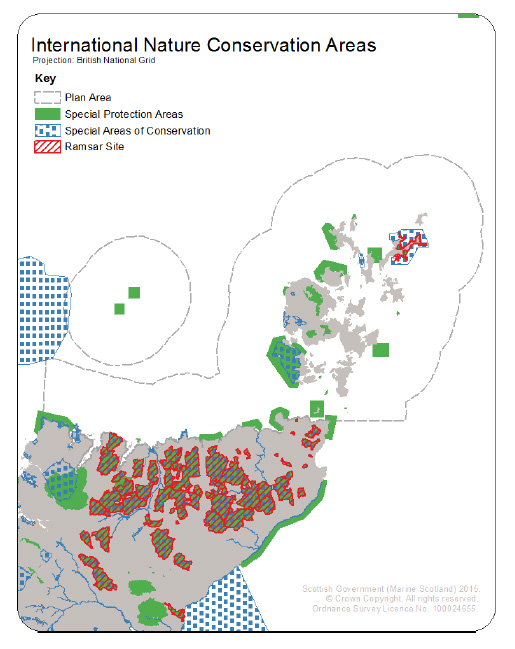
Figure 7.2 National Nature Conservation Areas in the PFOW Area [58]
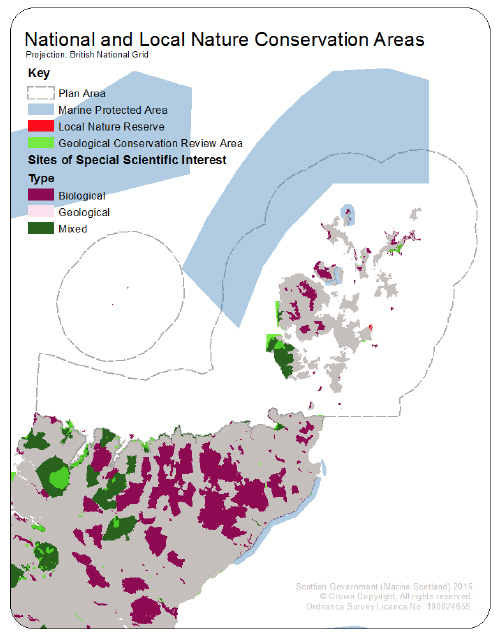
Figure 7.3 Seal Conservation Areas and Haul Out Sites in the PFOW [59]
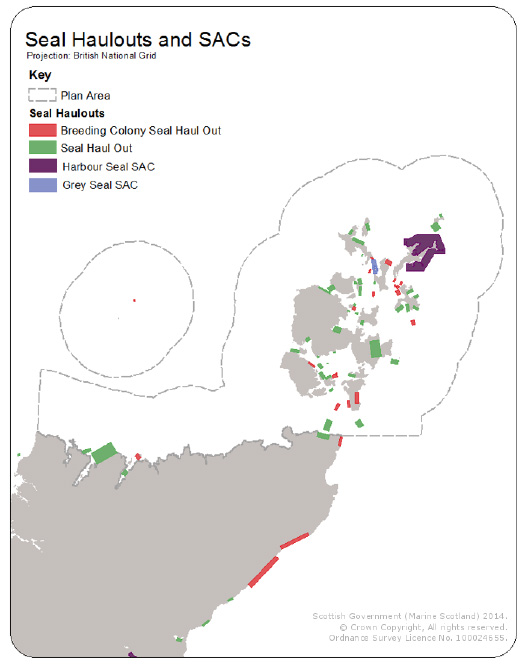
Figure 7.4 Atlantic Salmon Special Areas of Conservation in Scotland
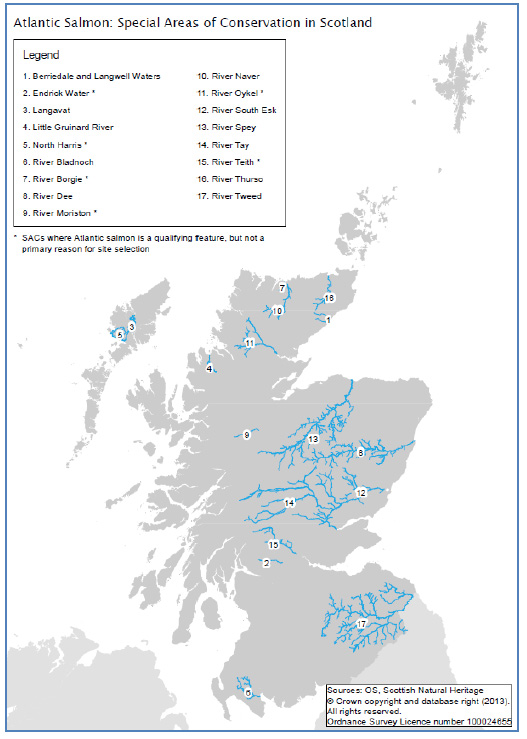
7.5 Climatic Factors
Predictions
7.5.1 Climate change has been predicted to lead to a range of effects on the marine and coastal environment, including an expected increase in water temperatures, rise in sea levels, changes in wave heights and subsequent changes to our coastlines. Since 1961, average temperatures in all parts of Scotland have risen for every season, and sea-surface temperatures around the UK coast have also risen by approximately 0.7 ºC over the last three decades. The UK Climate Projections 2009 model ( UKCP09) projects rises of 1.5 – 4.0 oC in temperature of shelf seas by the end of this century [60] .
7.5.2 Our seas are also becoming more acidic as increasing amounts of atmospheric carbon dioxide are absorbed at the sea surface, particularly those to the north and west of Scotland. A five-year baseline study has been initiated to investigate the seasonal and inter-annual variability of the carbonate chemistry of Scottish offshore and coastal waters, involving the collection of water samples from several locations including where the Atlantic and shelf waters meet near Orkney and Shetland [61] . Changes in temperature and acidity are a concern for marine ecosystems and the many organisms that share them. Such changes are considered likely to increase the vulnerability of some habitats and species, and also lead to additional changes in the marine environment.
7.5.3 There is clear indication that the effects of climate change are already creating changes in the marine environment. For example, increasing sea temperatures are known to already be leading to the extension of the northern limit of seabed animals and declines in the breeding success of some species of seabirds such as Arctic skua, Black-legged kittiwake and shag from decreases in food availability linked to climate change [62] .
7.5.4 While sea levels around the UK rose by about 1 mm/year in the 20th century (corrected for land movement), it is estimated that recent increases, particularly in Orkney, have been higher than this. The UKCP09 model projects further rises of between 16 cm and 68 cm above 1990 levels under a Medium Emissions Scenario for Kirkwall (used here as a proxy for PFOW). Given global carbon emissions a High Emission Scenario may be more relevant, which projects between 19 cm and 84 cm by 2100, above 1990 levels [63] . As discussed in the UK Climate Change Risk Assessment ( CCRA), more frequent coastal flooding is already present within parts of Scotland and tide gauges are expected to become more frequent and may coincide with more intense rainfall associated with the effects of climate change [64] . For example, increases in drought incidents during drier summers and increases in the frequency of extreme weather events are predicted [65] (e.g. storms and flooding). As a consequence, the predicted changes in sea levels are expected to exacerbate existing wave and storm surges, and this could have serious repercussions for marine and coastal environments. In particular, those coastal areas known to be susceptible to erosion and accretion, including numerous soft coastlines in Orkney, and the potential for knock-on effects for the industries operating in them.
Current Actions
7.5.5 Adaptation and mitigation of the predicted effects of climate change are a focus of Scottish Government commitments at the national and sectoral levels. The Scottish Government’s Climate Change Adaption Framework highlights these trends for sea level rise, air and sea temperatures, and atmospheric carbon dioxide ( CO 2) concentrations to be factored into future decision-making across all sectors, including those with interests in the marine environment [66] . Published in May 2014, the Scottish Climate Change Adaptation Programme was the first in an iterative process of programmes to address impacts and opportunities identified in progressive CCRAs. It sets out additional information on adaptation to climate change in the natural environment, including the marine and coastal environment, and Scottish Ministers’ objectives in relation to adaptation to climate change [67] . Sectoral plans such as the Marine and Fisheries Climate Change Adaptation Plan take adaptation forward at the sectoral level.
7.5.6 The Climate Change (Scotland) Act 2009 sets out a number of provisions for movement to a low carbon economy, setting legally binding national targets for GHG (i.e. at least a 42% in GHG emissions by 2020 and at least 80% by 2050, compared to the 1990 baseline). Other objectives have also been set, including the target for renewable energy sources to generate the equivalent of 100% of Scotland's gross annual electricity consumption by 2020, and an interim target of 50% by 2015. The Low Carbon Scotland: Report of Policies and Proposals 1 and 2 ( RPP and RPP2) [68] , [69] outline the range of policies and proposals that have been developed, and are being progressively implemented, to work towards the GHG reduction targets. Both are expected to play key roles in both reducing GHG emissions and Scotland’s reliance on fossil fuel combustion; including a variety of measures across numerous sectors, broadly focusing on improving efficiency in sectors such as energy generation and transport, improved efficiency in heating public, commercial and residential properties, increased use of renewable energy to displace more traditional sources, and amongst many others, supported by the development of a wide range of related policies.
Key pressures:
- Climate change impacts on coastal areas are expected to include sea level change, exacerbating the effects of extreme waves and storm surges, amongst others.
- Climate change impacts on marine ecosystems can include changing ocean acidity, salinity, rising sea temperatures and rising sea levels.
- Scotland has set targets and implemented actions for reducing GHG emissions across many sectors, including those for renewable energy generation and transport with the potential for increased spatial pressure on coastal and marine areas.
- Climate change adaptation is likely to be required in response to the predicted effects on the coastal and marine environment, particularly in the minimisation of impacts and the potential loss of vulnerable species and habitats.
7.6 Cultural heritage and historic environment
7.6.1 The PFOW area contains a wide variety of coastal and marine historic features. The rich marine heritage of Orkney and its waters in particular is demonstrated through the establishment of a voluntary underwater conservation zone in place around the remains of seven scheduled wrecks of ships from the German High Seas Fleet located within Scapa Flow. However, as shown in Figure 7.5, this provides just a glimpse of the many wreck sites identified in the waters around Orkney. The Pentland Firth and waters off the north Caithness and Sutherland coast are recognised for their high potential for submerged cultural features such as its prehistoric landscapes, shipwrecks and anchorages [70] . Designated wreck sites, such as the HMS Bullen and the wreck of HMS Duke of Albany receiving protection of Military Remains Act 1986 and located within the Firth and to its east respectively, are two such examples [71] , [72] of the vast number of wreck sites in the PFOW area. While many sites lie wholly within the marine environment, it is believed that there are many more unprotected sites of interest on and around Scotland’s coastline.
7.6.2 In addition to off-shore heritage, historic and cultural heritage sites are also in abundance across both the Orkney Isles and the north Caithness and Sutherland coast. These include a variety of listed buildings and scheduled monuments such as lighthouses, brochs, fortifications, cairns, chapels and dwellings, and other monuments with varying levels of listing and importance. Many of these sites, particularly those in Orkney, are located in coastal areas and as a consequence, have coastal or marine interests. Of particular importance is the Heart of Neolithic Orkney World Heritage Site ( WHS) occupying much of the west coast of the Orkney Mainland and Isle of Hoy [73] .
7.6.3 The north Caithness and Sutherland coast contains a number of historic features in coastal areas, principally consisting of listed buildings, gardens and designated landscapes, and historic monuments. In general the eastern part of this coastline contains a larger number of these coastal sites than the western portion, with the highest densities generally located in the more populated areas (e.g. Thurso, Scrabster) [74] . Of particular note within the Pentland Firth are the A-listed Pentland Skerries Lighthouses, Stackel Brae castle near the Pentland Firth, and monuments on the Island of Stroma; and on the north Caithness and Sutherland coast include the A-listed Castle of Mey and its designated gardens located near John O’Groats and around 500 m from the coast. Scheduled monuments in the region largely include the prehistoric coastal remains of brochs, standing stones, stone rows, tumuli and chambered cairns [75] . There are currently no Historic Marine Protected Areas ( HMPA) in the Pilot Plan area.
7.6.4 Previous SEA work undertaken on plans such as the Scottish Government’s Sectoral Plans for Offshore Renewables, amongst others, have highlighted the potential for significant effects of coastal and marine development on the historic environment, either directly or via impacts on setting. These have broadly noted that any such effects, and the sensitivity of historic and cultural heritage receptors to specific and cumulative effects, will require careful consideration and mitigation at the project level if they are to be developed within the marine spatial plan area. For some types of development, most notably for offshore wave and tidal technologies, guidance has been developed to aid those involved in developments and the development process on the potential for impacts on the historic environment, and to seek early resolution of any such issues [76] .
Key pressures to cultural heritage and the historic environment:
- Inappropriate development has the potential to affect the setting of cultural heritage and historic assets located in both coastal and marine areas.
- Construction/infrastructure installation works have the potential for both direct and indirect impacts to historic assets located in coastal areas or on the seabed, either as direct damage to historic features through seabed disturbance, or via secondary effects such as changes to coastal processes and sediment dynamics.
Figure 7.5 Submerged Archaeology in the PFOW [77]
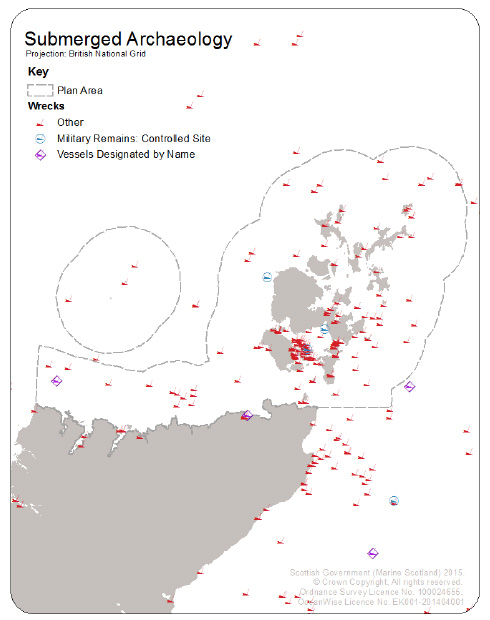
Figure 7.6 Coastal Archaeology in the PFOW [78]
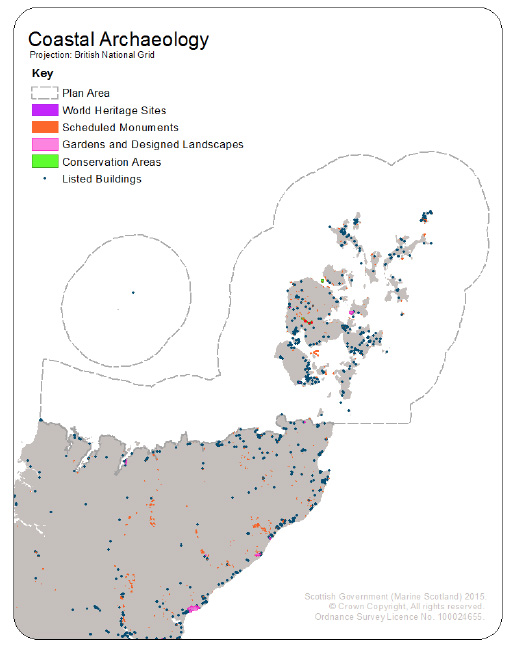
7.7.1 There are a large number of landscape designations at the national and local level within Orkney and along Scotland’s north coast, and many of these have with coastal and/or marine components. The scenic quality and character of Scotland’s landscapes are internationally renowned. Over 12% by area of Scotland has been classified as National Scenic Areas ( NSAs), supported by other levels of classifications including national parks and a range of local landscape designations.
7.7.2 Of Scotland’s 40 NSAs, two are located within the PFOW region (i.e. Hoy and West Mainland NSA, and Kyle of Tongue NSA) with each containing large sections of their respective coastlines. The special qualities identified by SNH for Hoy and West Mainland NSA include the archaeological landscape setting of the Heart of Neolithic Orkney WHS in addition to other aspects such as the layering of geology, topography, archaeology and land use, presence of sandstone and flagstone, the coastal scenery and the contrasts between different land uses (i.e. fertile farmland, unimproved moorland and townscapes), amongst others [79] . The wildness of Hoy has also been identified with some 4,990 hectares (ha) of land recognised as a wild land areas and areas of “high wildness” in a recent mapping exercise undertaken by SNH. The identification of areas such as this, along with several additional areas along or near to the north Caithness and Sutherland coast (e.g. Ben Hope to Ben Loyal, Foinaven to Ben Hee and Cape Wrath), have been recognised as being of national importance in the Scottish Planning Policy ( SPP) [80] .
7.7.3 The value attributed to the landscapes and seascapes along the north Caithness and Sutherland coast are further demonstrated through the identification of five Special Landscape Areas ( SLAs) by the Highland Council on the north coast of the Scottish mainland; including Oldshoremore, Cape Wrath and Durness located to the west of the PFOW area; Eriboll East and Whiten Head; Farr Bay, Strathy and Portskerra; Dunnet Head and Duncansby Head. The two SLAs at Dunnet Head and Duncansby Head are located immediately south of the Pentland Firth. Both areas are noted for their extensive seaward views and the landscapes they afford, particularly that of Duncansby Head with its complex landscape of cliffs, stacks, geos, arches, caves and wave cut platforms. These areas are known to be particularly sensitive to development which would affect views from the headland, or affect the perception of scale of the cliff landscape. The other SLAs located in the western portion of the PFOW and further west are noted for their both inland and coastal features, including their open sea views, indented coastline comprising rocky headlands and sheltered bays, and dramatic cliffscapes amongst others [81] .
7.7.4 Orkney’s landscape and seascape takes a strong coastal presence and includes coastal areas made up of rugged cliffs, beaches, enclosed bays, and isolated coasts; lowland marginal areas consisting of agricultural land and wetlands, amongst others; and rolling upland areas consisting of rolling heath and moorland hills and montane habitats [82] . It is anticipated that Local Landscape Areas ( LLAs) within Orkney will be developed by Orkney Islands Council in the future, and that this will be informed by new Landscape Character Assessment work to be undertaken by SNH to build upon that previously undertaken. The Orkney Islands Council is currently progressing with an application for funding for the North Isles Landscape Partnership Scheme [83] . The scheme will seek to explore landscape value of Orkney’s northern isles and look into the links with cultural heritage, amongst other aspects, and will follow on from the work of the Scapa Flow Landscape Partnership Scheme running from 2009 – 2012 [84] .
7.7.5 How a development impacts on landscape/seascape and geomorphology can often be a matter of individual perception, and in many instances, this can vary greatly depending on the type of development and locational factors (e.g. topography, distance). However, the assessment of landscape and visual impacts, and landscape character assessment are well-established methodologies. There is already considerable guidance available, such as that published by SNH relating to the siting and design of installations for the aquaculture industry and offshore wind, that has been developed to address both approaches to impact and capacity assessment, and also to help in minimising visual impacts. These principles have been previously applied for a wide range of marine and coastal development (i.e. offshore wind, aquaculture, pier/harbour expansion), and as such, some impacts can often be readily predicted for development in these sectors. However, it is also noted that the nature and significance of any such effects are less known for new or emerging sectors, such as wave and tidal renewables.
7.7.6 Previous SEA work undertaken for plans such as the Scottish Government’s Sectoral Plans for Offshore Renewables have also highlighted the potential for significant effects of developments on seascapes and coastal landscapes from coastal and marine development. These have broadly noted that any such effects, the sensitivity of valued and designated coastlines, and the potential for cumulative effects on them, will require careful consideration and mitigation at the project level if they are to be developed within the marine spatial plan area.
Key pressures for landscape and seascape:
- Sensitivity of coastal landscapes and communities to landscape and visual impacts from coastal and marine development as a result of their high landscape and seascape quality, natural character and wildness.
- Potential for cumulative impacts from often incremental and increased onshore and offshore development on landscape/seascape character and scenic value.
- Pressures on landscape/seascape in coastal areas from coastal erosion due to the expected effects of climate change, waste and inappropriate development.
Figure 7.7 Landscape designations in the PFOW [85]
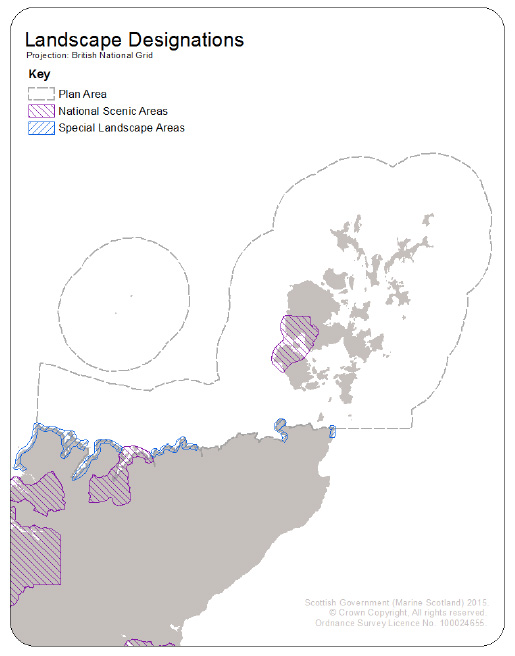
7.8 Soil, marine geodiversity and coastal processes
Designations
7.8.1 Many of Scotland’s coastal and offshore marine protected sites cover important coastal and marine habitats [86] . Some degree of protection is afforded to marine geology features through SAC designations, where the processes supporting the habitats and species are acknowledged, although it is the designation of coastal SSSI which offers the primary mechanism of protection for terrestrial and coastal sites to the seaward limit of local authority areas. Scotland’s SSSI are underpinned by the Geological Conservation Review ( GCR) undertaken by the JNCC [87] .
7.8.2 Further, a suite of Nature Conservation MPAs have also been developed to protect important areas of marine habitat, geology and geomorphology in Scottish waters [88] , [89], such as the North-west Orkney MPA (whilst protected for sandeels, it contains a range of geological formations including sand banks, sand wave fields and sediment wave fields) [90] , and Wyre and Rousay Sounds MPA and Papa Westray MPA interests (Marine Geomorphology of the Scottish Shelf Seabed) recognised for both biodiversity and geodiversity interests [91] , [92].
7.8.3 As shown in Figure 7.8, there are GCR sites located at several locations in Orkney, with the southern tip of Hoy and the coastline to the west of Stromness also identified. Concentrations of GCR sites also extend along the North Sutherland coastline near to Durness and Loch Eriboll and continue further inland, with smaller areas located on the coastline near to Thurso and Castleton, and further west of the PFOW near Cape Wrath [93] .
Coastal erosion
7.8.4 Scotland’s coastlines are varied in nature, representing around 8% of the coastline of Europe, and its geodiversity is evident in the PFOW area. Local variations in the hardness and composition of sedimentary rock layers, and differential erosion over millennia has led to a diverse and valued group of coastal forms. Some of these are widely recognised including, for example, the Old Man of Hoy and the Stacks of Duncansby. These cliffs are largely resilient and contrast susceptible formations such as the dune systems found in places such as Dunnet, Sanday and Westray, and the many pocket beaches interspersed with rocky coastlines and headlands amongst the Orkney isles and along the north Caithness and Sutherland coast [94] .
7.8.5 Coastal erosion and accretion are natural processes which are intrinsic attributes of dynamic soft shores. Where these affect built structures and assets, significant problems can occur. Sea level rise, reductions in coastal sediment supply and variations in storminess are the principal causes of coastal erosion. Human activities can play a role in exacerbating these natural processes (e.g. construction of sea walls, groynes and dredging in the near-shore) [95] , [96].
7.8.6 In 2004, the EUrosion project categorised Scotland's coast and summarised the character of the coastline, whilst assessing its potential stability and behaviour. This survey reported that Scotland’s coastline was comprised of predominantly hard coasts composed of rocks and cliffs (70%); soft coasts considered potentially susceptible to erosion impacts, composed of unconsolidated gravels, sand and silts (29%); and artificial coasts such as harbours and sea walls (less than 1%). In 2010-11, SNH updated the 2004 dataset and estimated that around 8% of Scotland’s coast was considered accretional [97] and an estimated 12% was erosional [98] , with shorelines with beaches, sand dunes, conglomerates/soft-rock cliffs, machair and marshes with muddy sediments identified as being particularly susceptible [99] .
7.8.7 Orkney is regarded as having one of the most active coastlines in the British Isles and coastal erosion and deposition is evident on many sections of the coast. The interaction of sea level rise, coastal erosion and deposition across millennia, has shaped the archipelago into its current form, which is reflected by and continues to expose archaeology across these islands. Coastal erosion has occurred over the last 10,000 years, and is likely to continue and to occur at an increasing rate based upon climate change predictions [100] . The spatial pattern and rate of erosion will be highly variable and based on local characteristics and circumstances, and in some instances, this is likely to impact communities, infrastructure, cultural and natural heritage [101] . As shown in Figure 7.12, parts of Sanday and Westray in particular are thought to be more susceptible to erosion. However this is being systematically investigated within the National Coastal Change Assessment in 2014 – 2015.
7.8.8 While the north Caithness and Sutherland coast is generally rocky and resistant to erosion, the EUrosion study identified sections of the coastline that had been affected or were vulnerable to erosion/accretion, including Thurso-Scrabster Bay, Portskerra and near John O’Groats, amongst others (see Figure 7.10) [102] .
7.8.9 In many instances, coastal erosion can create secondary impacts for coastal areas and the many assets they contain; for example, important sites of cultural and archaeological significance, and other known and undiscovered coastal archaeology [103] .
Bathymetry
7.8.10 Work undertaken on the development of the Offshore Renewables RLGs undertaken in 2013 considered detail on the sediment composition and included European University Information Systems ( EUNIS) predicted habitat data [104] . The seabed surrounding the Orkney Isles consists largely of coarse sediments such as sandy gravels and gravelly sands, with patches of sandy sediments to the south west near to the North Sutherland Coast, and to the south east of the Isles. Within the Pentland Firth, the seabed largely consists of undifferentiated rock.
7.8.11 The EUNIS dataset included in Figures 9 and 10 of the RLGs, described the Orkney seabed area as being generally composed of circalittoral coarse sediments, deep circalittoral coarse sediments and sands all around the Isles, with the exception of deep moderate and high energy circalittoral rock within the narrows of the Pentland Firth. Shallow and deep circalittoral coarse sediments were predicted to the east and west of the Firth, interspersed with circalittoral fine or muddy sand pockets offshore of the North Sutherland Coast. The composition of the sands is highly variable in its source as well as its size, with minerogenic sands (small grains of rock) supplemented by carbonate sands (fragments of shells and other marine life). The marine sediment pathways are highly complex and have led to considerable variation in the shell content on beaches and machair plains across the archipelago [105] .
7.8.12 The depth of the seabed varies greatly from 30 – 170 m around and within the Isles; the deepest areas being located to their north west beyond the offshore wind and wave plan option areas. Depths vary from 20 – 100 m within the Pentland Firth and off the North Sutherland coast, with the narrows of the Firth being the shallowest part.
Key pressures for soil, marine geodiversity and coastal processes:
- Pressures from coastal erosion due to natural effects, offshore or coastal development, and the expected effects of climate change have been widely identified.
- Pressure from sea level rise influencing both coastal erosion and flooding, and responses to it. For example, inappropriate planning and coastal defences can exacerbate issues or shift issues into nearby areas rather than alleviate the causes.
Figure 7.8 Geological Conservation Review Sites in the PFOW Area [106]
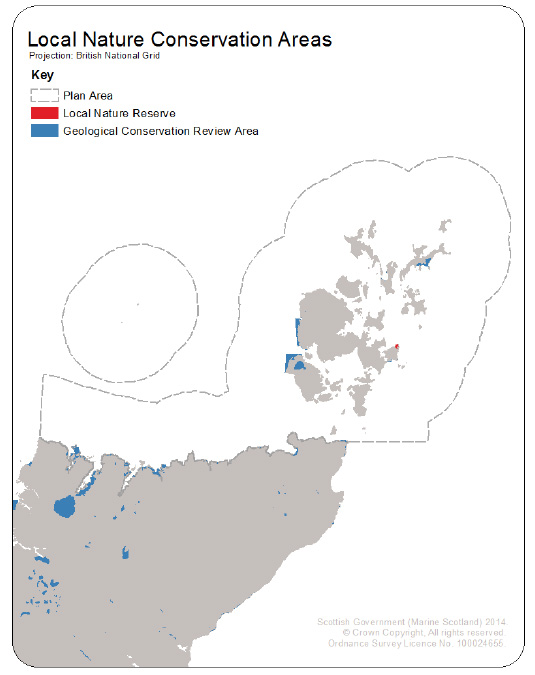
Figure 7.9 Coastal Geology in the PFOW [107]
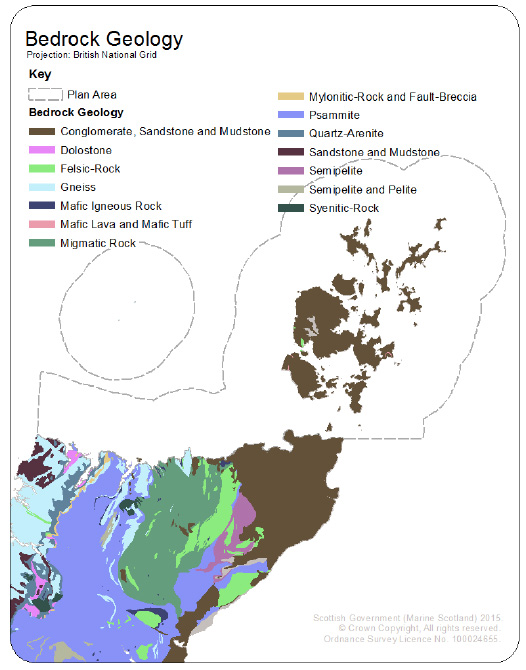
Figure 7.10 Seabed habitat in the PFOW area classified according to the European Nature Information System ( EUNIS) habitat classification system [108]
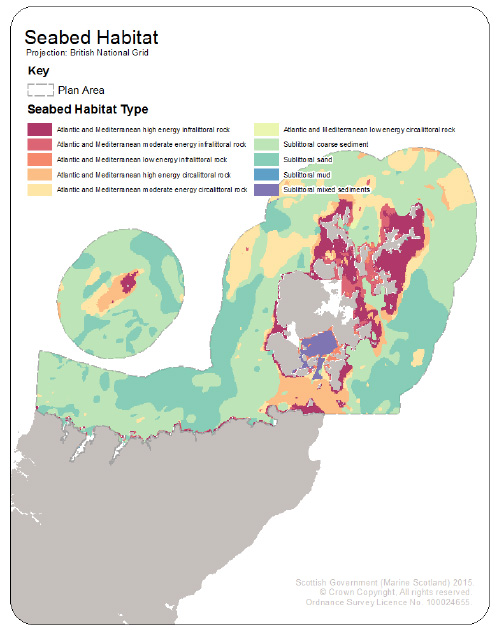
Figure 7.11 Eurosion Coastal Erosion Survey 2014 [109]
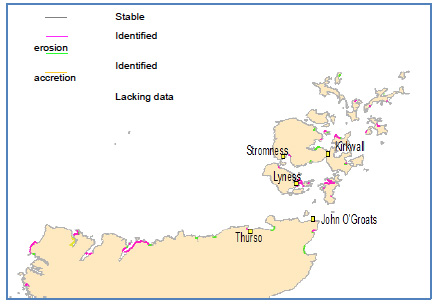
Figure 7.12 Eurosion Coastal Survey and Erosion Potential in PFOW [110]
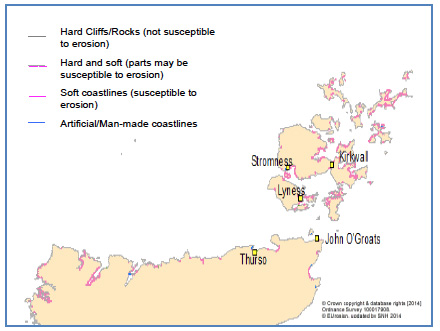
7.9 Communities, population and human health
Importance of the Marine Environment
7.9.1 The PFOW play an integral role for coastal communities within Orkney and along the north Caithness and Sutherland coast, both in terms of providing the means for economic support and also in supporting quality of life. Data from the Health Scottish Index of Multiple Deprivation ( SIMD) [111] indicates that communities on the Orkney mainland are largely ranked within top 40% of Scotland as being least deprived (ranked 60 – 100% in the SIMD). However, there are parts of the Northern Isles where health conditions appear to be in or moving towards the lower percentiles, and communities in the outer isles in Orkney were reported as being more deprived (ranked 20 – 60% in the SIMD). The most deprived area in the islands in the 2012 report was located in West Kirkwall on Orkney Mainland which was amongst the 35% most deprived areas in Scotland. Similarly, education and income domains data shows that deprivation in parts of the PFOW, including Hoy and the southern isles in the Orkney archipelago, are lower than many areas in Scotland. The 2012 SIMD also reported that communities along the north Caithness and Sutherland coast were ranked in the middle deciles (in the 40 – 60% range).
7.9.2 Core marine employment data demonstrates the importance of the marine sector in Scotland, particularly in the Northern and Western Isles, and in the Caithness region [112] . The PFOW marine environment offers opportunities in a range of sectors, attracting a wide range of marine users in supporting industries such as offshore oil and gas, aquaculture, and fishing sectors; and the recreational and tourism sectors ranging from activities such as swimming, surfing, recreational boating and yachting, diving, sea angling, and wildlife and cultural heritage tourism, amongst others. These activities not only provide opportunities in economic terms, but are also an important aspect in the quality of life in local communities in the region (see Section 7.11).
7.9.3 The area also contains important local services including ferries run by Northlink and Orkney Ferries between Orkney and Shetland, Orkney and the Scottish mainland, and between isles in the Orkney archipelago [113] , [114]. The importance of these links is reflected by long-term growth in passenger numbers on these services, particularly between the Scottish mainland and the Northern Isles. For example, in operating from the mainland to the Northern Isles, Northlink Ferries carried some 304,000 passengers in 2011, equating to around 1,000 (0.5%) less than in 2010 on the same routes, but around 46% more than in 2001. Orkney Ferries services operating within Orkney carried around 338,000 passengers in 2011, some 7,000 (2%) more than the 2010 and around 19% more than in 2001.
Risks to Human Health
7.9.4 In addition to environmental impacts, inappropriate development in the marine and coastal environment can affect both the quality of life and human health in local communities. Many effects may be indirect and temporary, arising from activities such as the construction of any new projects (e.g. increased boat traffic and harbour activity, and reduced access for key coastal walking, sailing routes or fishing grounds). However, longer term effects from operational developments or activities may also include create disturbance through factors such as noise and visual impacts for those people within proximity of certain activities or infrastructure (e.g. wind turbines, aquaculture sites, port and harbours). However, many such effects are also dependant on a range of factors including locational factors, sensitivity of receptors and the surrounding environment, amongst others.
7.9.5 Despite Scotland’s large marine areas, the high-level of use of the marine environment has proven to be hazardous. Marine Accident Investigation Branch ( MAIB) incident report figures indicate that a total of 7 collisions [115] and 14 groundings [116] have been reported for all vessels in Scottish waters since 2005. Of these, just four incidents occurred within or near to the PFOW area including a collision between a fishing vessel and the quay in Scrabster in 2014, the grounding of a jack-up barge and tug in the Stronsay Firth in 2006, and the grounding of a fishing vessel off Stroma in 2011. In January 2015, eight sailors were killed in the sinking of a cargo ship (the MV Cemfjord) off the Caithness coast. The most recent MAIB report outlined that while there were four fatalities on UK-registered merchant and fishing vessels in Scottish waters in 2013 related to fishing vessels floundering or fatalities associated with sailing vessels, none were located in or near to the PFOW region [117] .
7.9.6 Water quality can also be linked to human health, particularly in relation to recreation activities such as swimming and diving in the marine environment. The EC Bathing Water Directive seeks to preserve, protect and improve the quality of the environment and to protect human health [118] . As such, microbiological regulation and monitoring is driven by the risk to public health from pathogens in water, and bathing water quality is assessed in Scotland through the presence of total and faecal coliforms and faecal streptococci. If swallowed in sufficient quantities these can cause stomach upsets and ear infections [119] . While two locations in the PFOW at Dunnet Bay and Thurso are monitored, no sites are located in the Northern Isles. Dunnet Bay has been reported as meeting Guideline levels since 2010 and Thurso since 2013 [120] .
7.9.7 In a similar way, the quality of shellfish waters is assessed based on the presence of faecal coliforms (i.e. E. coli. content) in shellfish flesh, addressing the potential impacts on human health from consumption. While potential sources of water contamination are often difficult to distinguish, improvements in quality of these waters are currently being addressed through Scottish Water improving sewage effluent treatment and reducing storm overflows, and mechanisms such as RBMP preventing diffuse pollutants such as animal faeces from entering the water environment [121] .
Key pressures for communities, population and human health:
- Potential loss of amenity value of settlements, key routes and landscapes. Disturbance during construction works (e.g. noise, dust, displacement of activities).
- Potential for increased accident risk associated with greater use of the marine environment and installation of new infrastructure (e.g. collisions, capsizing in storm events).
- Potential for secondary effects on human health through impacts on water quality.
7.10 Water
Water Quality
7.10.1 The quality of the water environment has a crucial role to play in numerous industries within the PFOW area, particularly those in the aquaculture, fishing and water recreation sectors. The region’s diverse benthic marine habitats depend on good water quality to survive, and in turn to support other marine life, whether they are biological communities associated with the sea floor or at the top of the intertidal zone, resident species such as seals and harbour porpoise, or migratory species such as many cetaceans and Atlantic salmon, amongst others. Similarly, water quality is also related to human health through the consumption of fish and marine produce, and use of the marine environment. Whilst relevant to water quality, these issues are also considered under other environmental topics such as biodiversity (see Section 7.4) and communities, population and human health (see Section 7.9).
7.10.2 The primary mechanism for monitoring and managing the quality of Scotland’s waters is the WFD [122] , [123]. The WFD establishes a framework for the protection of all waters with the aim of ensuring all aquatic ecosystems meet ‘good status’ by 2015. The classification system is made up of different tiers and includes consideration of chemical, biological and hydromorphological parameters in water quality. The development of the second RBMP for Scotland and Solway-Tweed River Basin Districts ( RBD) is currently underway to address the requirements of the Directive in relation to the management of Scotland’s river systems. These plans also provide an overview of the state of the water environment for these districts [124] .
7.10.3 Monitoring undertaken by the Scottish Environment Protection Agency ( SEPA) identified that 97% of Scotland’s coastal waters had a high or good status in 2012, including waters within the PFOW [125] . While the PFOW are largely classified as being of ‘good’ status, the eastern portion of the Pentland Firth from Duncansby head southwards are of ‘high’ status [126] .
7.10.4 Bathing waters are classed as protected areas under Annex IV of the WFD due to their sensitivity to pollution or their economic, social and environmental importance. The EC Bathing Water Directive (2006/7/ EC) is translated into Scottish law by the Bathing Waters (Scotland) Regulations 2008, and aims to preserve, protect and improve the quality of the environment and to protect human health by setting out two quality standards (see Section 7.9).
7.10.5 The importance of water quality to coastal and marine industry is also reflected in other mechanisms, such as the designation of shellfish growing waters and support through the publication of guidance such as Marine Scotland’s Locational Guidelines for Marine Fish Farms [127] . This guidance designates areas on the basis of predictive modelling to estimate the nutrient enhancement and benthic impact, providing important tools for supporting water quality and sustainable industry development. While some 84 Shellfish Waters Protected Areas are designated under the Water Environment (Shellfish Water Protected Areas: Designation) (Scotland) Order 2013, just three sites are located within the PFOW area. These are the Bay of Firth on Orkney Mainland, and Loch Eriboll and Kyle of Tongue in the North Sutherland Coast [128] (see Figure 7.14).
7.10.6 In 2011, all Scottish shellfish waters complied with the minimum environmental quality standards (the ‘mandatory’ standard) set by the Directive, and around 55% met the more stringent guideline quality standard (the ‘guideline’ standard) [129] . The Food Standards Authority ( FSA) also monitors shellfish harvesting areas including those in Orkney and the North Sutherland Coast, undertaking biotoxin monitoring programmes, and has the authority to advise members of the public against harvesting wild shellfish in these areas based upon monitoring results. Monitoring results are published weekly and an annual Shellfish Classification Document prepared providing all classified shellfish harvesting area details for the forthcoming year [130] . In these reports, some sites in the region such as Loch Eriboll were classified as favourable for 2015 – 16; whilst the classification of others such as Kyle of Tongue were changed to unfavourable. Some areas have been declassified in recent years by the FSA, including the Bay of Firth Shellfish Harvesting Site for Pacific Oysters (Crassostrea gigas) for two areas (Bay of Firth and Bay of Firth – Shore) in 2010 [131] and the Rabbit Islands in the Kyle of Tongue in 2015 [132] .
7.10.7 Further, based upon monitoring results, commercial shellfish harvesting was temporarily banned by the Orkney Islands Council at Fersness Bay in 2013, due to raised levels of toxin-producing plankton being detected in the area and the potential for shellfish gathered from the shores of the Bay being unsafe to eat.
Potential Contamination Sources
7.10.8 Potential sources of pollution of the water environment and the pollutants entering the water environment can be varied, ranging from shipping and boating (e.g. the use of anti-fouling tributyltin and copper paints [133] , and other synthetic substances [134] ); oil discharges from incidents, collisions or the release of ballast water [135] ; introduced non-native species from ballast or vessel hulls; discrete and diffuse terrestrial sources (e.g. natural weathering, industrial discharges and agriculture [136] ), atmospheric sources (e.g. chemical contaminants and dust [137] ); marine and beach litter including public litter, sewage related debris, fishing and shipping litter [138] ; radioactive contamination (e.g. naturally occurring radioactive material ( NORM), wastes [139] and accidental releases [140] ); and munitions contamination and military waste [141] .
7.10.9 In many instances, these are most likely to be localised and site specific sources, but may also be exacerbated by external factors such as the effects of climate change which can reduce the ability of the water environment to safely absorb and break down pollution. For example, the likelihood of reduced summer rainfall may mean less water is available in rivers and inland waters for diluting pollutants during these periods [142] and higher annual river flows, particularly during winter months, may help to dilute pollutant discharges to rivers while increasing the quantity reaching coastal and marine waters.
Key pressures for the water environment:
- Potential for contamination of the water environment from marine or coastal activities such as the use of anti-fouling paint, pollution from oil spillage and sewage, construction activities, amongst others.
- Potential for pollution of coastal waters resulting from activities on land; particularly agricultural activities, industries discharges and storm water runoff.
- Potential for secondary impacts to coastal and marine industries such as inshore fisheries, tourism and aquaculture, amongst others.
- Potential for secondary impacts to coastal and marine biodiversity, including impacts of marine litter and other marine activities.
Figure 7.13 Coastal and Transitional Waters Classification 2012 [143]
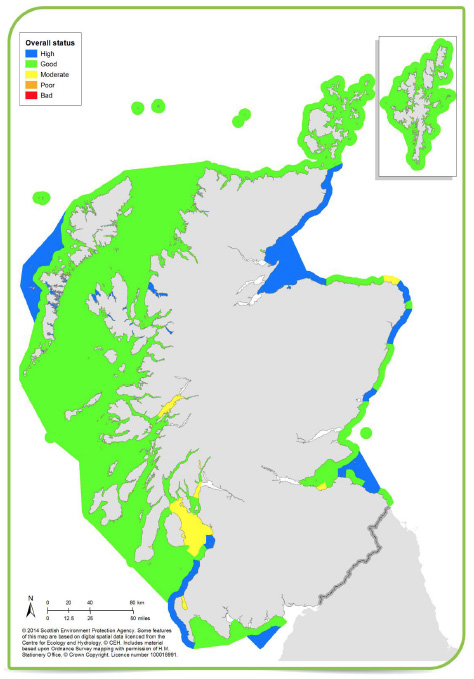
Figure 7.14 Location of Shellfish Waters and Active Aquaculture Sites in the PFOW Area [144]
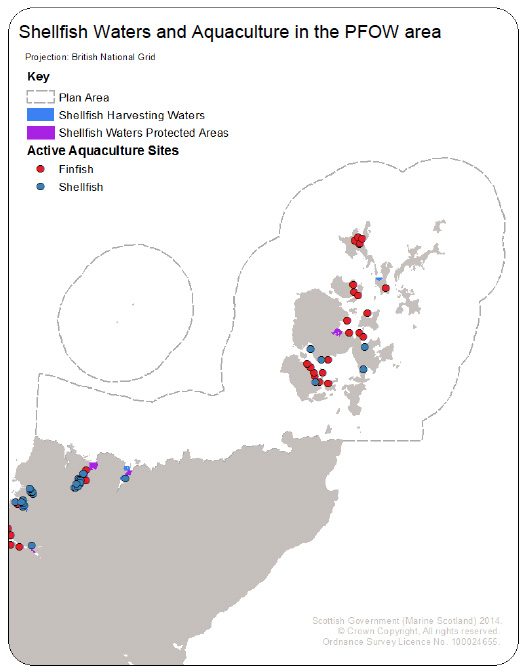
Shellfish Waters and Aquaculture in the PFOW area
7.11.1 The coastal and marine environment of the PFOW is a key resource for the region and for Scotland as a whole, demonstrated by the many varied sectors and industries that use these waters and the surrounding coastlines. The Socio-economic Baseline and the RLGs are presented in stand-alone reports, and these documents present spatial information on the specific activities and industries operating in the PFOW area.
7.11.2 This information is not duplicated in this SA Report, but rather an overview of the information discussed in the Socio-economic Baseline Report and the RLGs, and key issues of relevance are provided in the following sections.
Aggregates and Dredging
7.11.3 No marine aggregate extraction currently takes place in Scottish waters and there is currently no identified development pressure for the extraction of marine aggregates in the PFOW area. However, dredging has been undertaken in the PFOW area to maintain safe port operations and keep waterways navigable.
7.11.4 Some 11 disposal sites in the PFOW have received dredged material between 2001 and 2013 including two sites at Scrabster, three at Stromness, and one each at Dounreay, Thurso, Kirkwall, Orkney, Gills Bay and Scapa [145] .
Aquaculture
7.11.5 Orkney in particular has a strong aquaculture presence, and according to the Scottish Shellfish Farm Production Survey, some 29 aquaculture sites (22 finfish and 7 shellfish) are located within the PFOW area. As illustrated in the Socio-economic Baseline Report and in Figure 7.14, these sites are scattered through the sheltered bays around the Orkney Isles [146] and also in lochs such as the Kyle of Tongue and Loch Eriboll on the north Caithness and Sutherland coast [147] . As noted in Section 7.10.5, three Shellfish Water Designations are located within the PFOW area including the Bay of Firth on Orkney Mainland, and Loch Eriboll and Kyle of Tongue in the North Sutherland Coast.
7.11.6 The annual production of Atlantic salmon from Orkney sites accounted for around 7.0% of total Scottish production in 2013. In the same year, there was no production from Orkney shellfish sites (i.e. no harvesting of shellfish for market). While data is available for shellfish sites in the Highlands, this data is collated so as to avoid being able to identify individual farms or people and the data, as presented in the Production Survey, therefore cannot provide detailed spatial information for this area [148] .
7.11.7 Sustainable growth targets have been set for the Scotland’s aquaculture industry, with the support of the Scottish Government and with due regard to the marine environment by 2020. The national targets are to increase marine finfish production sustainably to 210,000 tonnes (in 2013, production was 165,256 tonnes) and shellfish production to 13,000 tonnes (in 2013, production was 6,757 tonnes) [149] .
Commercial Fisheries
7.11.8 The PFOW forms a major base for Scotland’s fishing sector, with Scrabster and Orkney vessels having employed 429 fishermen on a regular basis and 164 fishermen on an irregular (or part-time) basis in 2013. Some 16,378 tonnes (worth around £17.2 million) of fish on average between 2009 and 2013 landed from within the PFOW defined rectangles. In 2013, landings by Scottish vessels into Scrabster district ports weighed some 12,724 tonnes (worth around £19.9 million) and those in Orkney were some 3,836 tonnes (worth around £7.2 million) 27.
7.11.9 Landings into Scrabster district ports in 2013 were predominantly demersal species making up almost 75% of landings into Scabster district ports, with 25% being shellfish species and a small quantity of pelagic species. Almost 99% of landings by quantity into Orkney district ports in the same year were made up of shellfish species (i.e. nephrops), with minor quantities of pelagic and demersal species also recorded [150] .
7.11.10 The PFOW region and surrounding areas contain numerous salmon rivers, most notably the River Borgie and River Thurso SACs [151] on the north Caithness and Sutherland coast. Many of these rivers attract recreational rod and line fisheries, typically within these rivers above tidal limits [152] . Many retained and ‘catch and release’ fisheries operate in Scotland, including numerous operations along the north Caithness and Sutherland coast, targeting recreational anglers for both Atlantic salmon and sea trout species [153] . As shown in Figure 7.15, active coastal net fisheries also operate along the north Caithness and Sutherland coast targeting Atlantic salmon and sea trout species. Over the last five years, the three largest coastal net fisheries in any given year accounted for between 65 – 80% of the total Scottish coastal net catch, including one operating off the north Caithness and Sutherland coast [154] .
Figure 7.15 Scottish fishery districts containing active coastal net fisheries in 2013 [155]
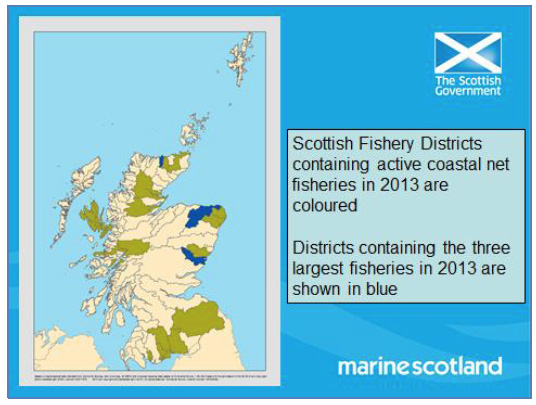
Defence
7.11.11 Ministry of Defence ( MoD) Military exercise areas are located in the PFOW area, including danger areas located to the east of Orkney and the Pentland Firth and exercise area located immediately west of the Pentland Firth from Loch Eriboll to Cape Wrath. These include the Cape Wrath official gunnery and bombing range, mainly used for live gunnery practice by the Royal Navy and allied navies and for live bombing practice by the Royal Air Force ( RAF) and the Fleet Air Arm ( FAA); a ‘firing danger’ and ‘other’ exercise area to the East of Orkney [156] .
7.11.12 MoD Danger Areas have also been identified at Cape Wrath and in the western part of south west portion of the Orkney Mainland near to Stenness. The Orkney site, called Ramsdale, is located inland [157] . The Vulcan Naval Reactor Test Establishment, operated by the MoD is located next to the Dounreay site in Caithness [158] .
Renewable Energy Generation
7.11.13 The strong tidal currents in the Pentland Firth and in channels amongst many of Orkney’s Islands, and the strong wind and wave features off the north and north-west coasts of Orkney have been identified as having the potential for further exploration for renewable energy [159] . This is reflected in the development of Plan Options for wind energy (one area to the north and north-west of Orkney), wave energy (one area to the north and north-west of Orkney) and tidal energy (four areas including the Pentland Firth, Stronsay, off Papa Westray and North Ronaldsay) in the PFOW area through the development of the Sectoral Plans for Renewable Energy by Marine Scotland in 2013 [160] .
7.11.14 The vast energy potential of the wind, wave and tidal resources in the PFOW region is the focus of much research and work in the renewables sector at present. Demonstrator and research sites such as the European Marine Energy Centre ( EMEC) facilities at Billia Croo and Scapa Flow (wave), and Fall of Warness and Shapinsay Sound (tidal), amongst numerous smaller planned or operational sites [161] , are currently in use in the PFOW to test and investigate a range of wave and tidal technologies. A range of sites have been leased for wave and tidal development, including Inner Sound and Ness of Duncansby on the north Caithness and Sutherland coast, and the west Orkney South, Brough Ness and Lashy Sound sites in Orkney, amongst others [162] .
7.11.15 The Scottish Islands Renewable Project identified employment opportunities based around the wind, wave and tidal renewables sector in Orkney. Full details of this and further discussion on existing lease and demonstrator sites is discussed in detail in the Socio-economic Baseline Report [163] .
Pipelines, Electricity and Telecommunications Cables
7.11.16 A number of subsea power cables have been laid within the PFOW area including two 33 kilovolt (kV) cables connecting Orkney with mainland Scotland. Due to the increasing volume of renewable generation which has been connected or contracted to be connected, the connection has now reached full capacity.
7.11.17 In the PFOW area, Scottish and Southern Energy Power Distribution ( SSEPD) has been undertaking work in relation to the ‘Orkney Caithness’ 132 kV reinforcement connection since the Crown Estate Leasing Round in 2010. The existing cable between Orkney and Caithness is at full capacity and SSEPD are looking at options to develop a new connection to allow marine renewable developers to connect to the transmission network on Caithness. This will provide grid access for marine renewable projects, and potentially onshore wind projects across the whole of Orkney.
7.11.18 There are four international telecom cables intersecting the PFOW area. The Northern Lights telecom cable, owned by BT was installed in June 2008, and connects Orkney to the Scottish mainland, and intersects West Orkney South and Brough Head wave renewables sites. While the cable has sections which are buried, it has others which are laid on the seabed, including those sections intersecting with these sites [164] .
Leisure, tourism and recreation
7.11.19 The importance of the PFOW to activities such as tourism and recreational operations is well established (e.g. diving, sailing and boating, angling). Tourism in particular is estimated to contribute greatly to the local economy in the region, with much interest centred on historic, cultural and natural heritage attractions such as the United Nations Educational, Scientific and Cultural Organization ( UNESCO) WHS in Orkney, scuba diving at designated wreck sites, wildlife tourism utilising many of the natural assets that the PFOW area is known for (e.g. seabird populations, marine fauna and flora), and regular cruise ship visits to Orkney, amongst others.
7.11.20 Recreational activities such as surfing, sailing, cruising, rock climbing on coastal cliffs, sea angling, sea kayaking, coastal walking and cruise ship visits, amongst others, combine to make this an important sector in the PFOW area [165] . As a consequence, tourism and recreation plays an important role in providing economic opportunities for many sectors, including employment opportunities either directly (e.g. tour operators, employment at cultural heritage sites) and indirectly through the provision of related services (e.g. accommodation and hospitality) [166] .
Marine Transport, Ports and Harbours
7.11.21 The Pentland Firth is recognised as a route of international importance for navigation and is considered to be crucial for shipping and navigation, despite being one prone to strong tides, heavy seas and poor weather conditions. The range of shipping in the PFOW region is diverse, broadly including ferry services between the Scottish mainland and the Northern Isles, ferry services between isles in Orkney, freight vessels including important shipping routes between Orkney and Shetland and through the Pentland Firth, cruise ships, supply vessels, heavy lifting and positioning vessels, dive boats, fishing vessels and recreational craft [167] . The area is used extensively by commercial cargo vessels as a major route from the North Atlantic to the North Sea, and as such, the PFOW often contains a high density of vessel traffic, particularly in the vicinity of Scapa Flow and near Kirkwall Harbour [168] .
7.11.22 In all, Orkney contains 29 piers and harbours [169] , and port facilities of varying sizes are present throughout the PFOW. Many are local authority-owned, the largest being Kirkwall Harbour which services a range of fishing vessels, ferries and recreational craft, amongst others. Dredging has been undertaken at several of these harbours to allow for expansion of port facilities at sites such as Hatston, Stromness and in Scapa Flow, and is still undertaken to maintain harbour access for large vessels at some locations.
7.11.23 Many ports and harbours are also dotted along the north Caithness and Sutherland coast, ranging from small piers that service fishing and recreational craft, to others such as Thurso, Scrabster and Gills Bay, that are used by larger vessels such as roll-on roll-off ( RORO) ferries, servicing a range of marine sectors and providing important connections between the Scottish mainland and the Northern Isles, as well as servicing many of the smaller islands spread throughout the Orkney archipelago. As well as transporting passengers, many of these ferries are also used in the transport of commercial goods and freight and as such, provide important connections for many more remote communities in the PFOW area [170] .
7.11.24 Some of these ports have been identified as having the potential to play important roles in the growth of the offshore renewables sector in the region; including having the potential to support manufacturing, assembly/construction and installation, operations and maintenance activities, and/or having the potential to support sector through the wet storage of infrastructure. The National Renewables Infrastructure Plan ( NRIP) and Marine Renewables Infrastructure Plan ( MRIP) sought to provide an early assessment of the emerging industry needs of the offshore renewables sector, and in the identification of the suitability of current infrastructure provision throughout Scotland in meeting these needs. To this end, ports at Stromness, Hatston/Kirkwall, Lyness, St Margaret’s Hope, Scrabster, Gills Bay and Burwick were identified in the MRIP published in August 2014. Further sites located near to the PFOW area, such as Wick, were also identified [171] .
7.11.25 The importance of the ports and harbours in the PFOW area is demonstrated both in social terms through the supporting services that they provide to communities throughout the Orkney Archipelago, and also in terms of employment and economic benefits. This is discussed in further detail in the Socio-economic Baseline Report [172] .
7.11.26 The Safer Ships, Cleaner Seas report published in 1994 [173] recommended that “that a comparatively limited number of areas of high environmental sensitivity, which are also at risk from shipping, should be identified and established around the UK coast”. These areas were identified as Marine Environmental High Risk Areas ( MEHRAs), and one such area was identified along the south west coastline of Hoy at Torness, adjoining the Pentland Firth [174] .
Oil and Gas
7.11.27 While there are no hydrocarbon fields within the PFOW area, the Flotta Oil and Gas Terminal in Scapa Flow is of prime importance to the oil and gas sector, particularly as it receives crude oil via a 30 inch pipeline running via Water Sound between Burray and South Ronaldsay from several offshore facilities located in the North sea. Transhipment by tankers also takes place at the Terminal and ship transfers are undertaken within the sheltered anchorage provided by Scapa Flow. Surface installations for the sector are located in Scapa Flow and to the north west of Orkney Mainland.
7.11.28 Scrabster Harbour is the nearest port of call on the Scottish mainland for oil fields located to the west of Shetland. A range of businesses located along the north Caithness and Sutherland coast support the sector and operate in the oil and gas supply chain, and as a consequence, also provide employment opportunities in the region [175] .
7.11.29 While no known oil or gas exploration is currently planned for the PFOW area, the West of Orkney Phase 2 blocks licensed for hydrocarbon extraction are located to the west the PFOW area [176] , [177].
Key pressures for material assets:
- Increased use of coastal and marine resources within the PFOW and the increased potential for cumulative effects associated with activities in these sectors.
- While many activities have the potential to be compatible and co-exist in the PFOW area, there may be the potential for displacement of some marine users from increased activity and the placement of infrastructure in marine or coastal areas.
7.12 Likely Evolution of the Baseline in the Absence of the Plan
Trends and Pressures
7.12.1 Many of the pressures and trends identified in the socio-economic and environmental baselines are likely to be independent of the both the Pilot Plan and development and use of the PFOW area in general. For example, climatic change is likely to be largely unaffected by the growth of coastal and marine use in the PFOW, and in the global context in particular, the predicted effects of climate change are expected to continue with current trends irrespective of the Pilot Plan. However, seeking opportunities to improve adaptation and resilience in coastal and marine use to these predicted effects, and reduction in GHG emissions are ambitions of the both the draft Pilot Plan and of wider programmes (e.g. those outlined in RPP and RPP2, the NMP).
7.12.2 Other trends and pressures, such as those related to biodiversity (e.g. seabird and seal population trends), water quality (e.g. acidification, diffuse pollution) and seabed and marine geology (e.g. loss of habitat and changes to coastal processes from offshore development and some fishing practices) amongst others, are the product of complex interactions and relationships. Many of these largely relate to a variety of man-made factors including inappropriate development and unsustainable use of resources, and existing pressures on the coastal and marine environments (e.g. onshore activities contributing to reduced water quality and litter/waste in rivers, estuaries and coastal waters). In the future, increased development and use of the PFOW is likely to further exacerbate existing pressures on resources and the natural environment, particularly the over-use of resources or if the region is over-developed. As the use of the coastal and marine environments progressively change, it is likely that new or additional pressures on its resources will be identified and the environmental baseline would change accordingly.
7.12.3 Work is already being undertaken to investigate and address many of these trends and pressures. For example, research studies undertaken in academia, by various industries including those undertaken as part of or as a condition of consenting processes, and by the Scottish Government and/or Marine Scotland is likely to continue to develop to identify and address data gaps on a needs basis (e.g. the Scottish Offshore Renewables Research Framework ( SpORRAn), Offshore Renewables Joint Industry Programme ( ORJIP)). This work includes research and monitoring of seabird populations, investigations into reasons behind declines in seal populations (e.g. research into ‘corkscrew’ injuries) and sectoral work to reduce the influx of diffuse pollutants into waterways have become important areas of work to address specific concerns.
7.12.4 Further work on the assessment and mitigation of pressures, such as the evolving field of coastal classification and development of methodologies for the assessment of landscape/seascape effects, would also likely continue to be developed as required by the industries involved. Similarly, project specific assessments through processes such as Environmental Impact Assessment ( EIA) and HRA are well-established for many types of development and marine uses; all of which would be expected to continue under current mechanisms regardless of the adoption of the Pilot Plan.
7.12.5 Wider work on the preservation of the natural environment and improving socio-economic factors in the PFOW and Scotland is likely to continue regardless of adoption of the Pilot Plan. For example, work in improving the management of our rivers and seas (e.g. River Basin Planning and establishment of River Basin Districts), improving water quality and biodiversity (e.g. the National Litter [178] and Marine Litter Strategies [179] , 2020 Challenge for Scotland’s Biodiversity [180] ), and reducing the potential for adverse effects on these environments (e.g. via the Marine (Scotland) Act 2010, research and studies into potential impacts of marine activities on the natural environment, existing consenting processes), amongst many others. Further, a range of programmes for improving health and wellbeing in Scotland involving reducing poverty, improving health and mental wellbeing, maintaining connectivity (e.g. Scottish Ferry Services: Ferries Plan (2013-2022) [181] ), fostering community empowerment (e.g. Community Empowerment Bill 2014 [182] ) and improving economic growth in the national and regional contexts (e.g. the Government Economic Strategy [183] ), amongst many others in the socio-economic context, will continue to work to improve current concerns and reverse current negative trends, in the absence of the Pilot Plan.
Growth of use and development
7.12.6 The growth of development and use of the PFOW has historically been largely market driven, whilst also being influenced by a range of strategic and policy factors (e.g. offshore renewables planning, inshore fisheries planning). Even with the adoption of the Pilot Plan, further development and use of the PFOW would likely continue to be largely market-lead in the future with any future development/marine use continuing to be within the existing consenting processes detailed under current legislation.
7.12.7 Similarly, current trends and impacts to biodiversity, soil and marine geology, cultural heritage and water quality, in particular, would likely continue to be influenced in this way if not addressed in other avenues (see Section 7.12.3. For example, through the role of the existing regulatory framework in identifying and reducing the likelihood of adverse environmental effects from development in the region (e.g. cumulative effects, risk of soil or water contamination from discharges, protection for the historic environment, protection for designated species and habitats).
7.13 Difficulties encountered in compiling the information
7.13.1 Given the strategic nature of the Pilot Plan, there is a degree of uncertainty surrounding the potential impacts in adopting some policies, particularly as many are likely to be influenced by a range of site and project-specific locational factors. For example, while methodologies have been established for the assessment of landscape/visual impacts and landscape character assessment (see Section 7.7), the nature and significance of visual and landscape/seascape issues depends largely on locational factors and can also differ greatly with an individual’s perception. As a consequence, both can introduce a degree of uncertainty in considering the significance of any environmental effects. Based upon this, the potential and general effects have been identified and discussed within this assessment in the context of the various sectors and their coastal and marine operations, and with spatial consideration where possible.
7.13.2 Much of the uncertainty encountered also relates to the relatively new and continually evolving nature of marine planning. This is reflected in the development of Scotland’s NMP in particular, and also the relationship with others such as the Sectoral Plans for Offshore Renewables and the development of Scottish MPAs.
7.13.3 Further, whilst new information on the marine environment continues to emerge, uncertainty remains around many of the interactions between marine features and our use of the marine environment. Although a great deal of research has been undertaken on Scotland’s marine and coastal environments through public bodies such as MSS and SNH, in academia, by non-government organisations ( NGOs) and within the many industries with coastal and/or marine interests, it is widely acknowledged that significant data gaps remain. Such gaps in knowledge have introduced further uncertainty in undertaking environmental assessment, largely via the compilation of a meaningful environmental baseline, and in the evaluation of the likelihood and extent of potential effects that may be associated with potential future developments (e.g. offshore renewable energy development). This has enabled the development of strategies to fill these gaps, including through the work of formal groups such as the SpORRAn, amongst many others.
7.13.4 In many instances, more comprehensive information on a wide range of issues could have added greater detail and precision to the assessment, even at this high-level, and may also have provided greater certainty moving forward with marine planning in the PFOW. For example, additional information on the movement of migratory species (i.e. cetaceans, salmon and lamprey, seabirds and elasmobranchs) and greater certainty of effects associated with marine infrastructure (e.g. the precise effects of electromagnetic forces ( EMF), collision and entanglement risk, sedimentation issues) are just two examples where it may be beneficial in identifying potential interactions and could help to avoid/mitigate potential adverse effects. Many of these gaps, limitations and difficulties have fed into the generation of the recommendations and monitoring set out in Section 10.3 of this report, as well as being identified as important outcomes of other planning processes.
Contact
There is a problem
Thanks for your feedback